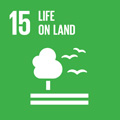- Docente: Riccardo Testolin
- Credits: 4
- SSD: BIO/03
- Language: Italian
- Teaching Mode: Traditional lectures
- Campus: Bologna
- Corso: First cycle degree programme (L) in Natural Sciences (cod. 5823)
-
from Mar 03, 2025 to Apr 23, 2025
Learning outcomes
At the end of the course, the student has an overall view of habitats with different degrees of naturalness/artificiality, described through vegetation characters and the methods to be adopted for their description, with reference to European regulations. A particular focus concerns the problems resulting from the anthropic impact.
Course contents
Biodiversity Conservation
- Theoretical principles of ecosystem conservation.
- International conventions for nature protection.
- Network of protected areas at European, national, and regional levels.
- Biodiversity indicators and measurement methods.
Acquired Skills
- Knowledge of the main nature protection systems.
- Understanding of different biodiversity concepts and quantitative assessment indices.
Vegetation Analysis and Habitat Monitoring
- Habitat classification systems.
- Methods for studying vegetation.
- Tools for habitat mapping and monitoring.
Acquired Skills
- Knowledge of characteristic habitats in the regional territory.
- Familiarity with major biodiversity classification systems.
- Theoretical and practical skills in cartographic techniques and habitat monitoring.
Field Trips and Practical Activities
- Three one-day field trips to explore conservation, management, and habitat monitoring techniques.
- Two practical exercises on habitat mapping using GIS tools.
Readings/Bibliography
PDFs of each lecture will be provided to students at the end of each topic.
Due to the heterogeneous nature of the course, there is no single reference textbook. The topics covered in class are largely based on the following sources:
- Magurran, A. E.; McGill, B. J. (eds.). Biological Diversity: Frontiers in Measurement and Assessment. OUP Oxford, 2010.
- Giacomini, Valerio. La Flora. Conosci l'Italia, Vol. 2. Touring Club Italiano, 1958.
- Quaderni Habitat: https://www.mase.gov.it/pagina/i-quaderni-habitat-collana
- Angelini P., Casella L., Grignetti A., Genovesi P. (eds.). Manuali per il monitoraggio di specie e habitat di interesse comunitario (Direttiva 92/43/CEE) in Italia: habitat. ISPRA, Serie Manuali e Linee Guida, 142/2016.
Not all the content of the recommended texts is relevant for exam preparation, and purchasing the books is not required. Students should select the topics to study for the exam based on the course syllabus.
Most of these texts are available for consultation at the University libraries.
Teaching methods
The course is mainly carried out through (i) lectures with video projection and (ii) educational excursions aimed at getting to know some of the main regional habitats described in class under the guidance of the teacher and any collaborators. These teaching methodologies can be integrated with the organization of seminar meetings with technicians who are experts in specific topics of the teaching programme.
In consideration of the types of activities and teaching methods adopted, the attendance of this training activity requires that all students carry out in e-learning mode [https://www.unibo.it/it/servizi-e-opportunita/salute- e-assistance/health-and-safety/safety-and-health-in-places-of-study-and-traineeship] and participation in module 3 of specific training on safety and health in places of study. Information on dates and methods of attendance of module 3 can be consulted in the appropriate section of the study course website.
Assessment methods
The assessment test is oral and includes the discussion of the topics covered in class and during the educational excursions.
The evaluation is based on the individual student's knowledge of the topics in the program and on the quality of the presentation. The duration of the oral exam is on average 20 minutes.
Teaching tools
Presentations of the lessons held by the teacher, publications and scientific reports provided by the teacher, specialized websites, PC, video projector.
All teaching material is made available to students in advance through the Virtual portal (virtuale.unibo.it).
Office hours
See the website of Riccardo Testolin
SDGs

This teaching activity contributes to the achievement of the Sustainable Development Goals of the UN 2030 Agenda.
